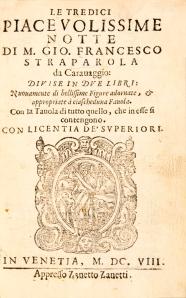Europe’s First Literary Fairy Tales
Giovanni Francesco Straparola. Le Tredici Piacevolissime Notte. Venice: Zanetto Zanetti, 1608.
 Although today the fairy tales of France’s Charles Perrault and Germany’s Jacob and Wilhelm Grimm are perhaps better known, the first literary fairy tales published in Europe appeared in Giovanfrancesco Straparola’s Le piacevoli notti, or The Pleasant Nights (Venice; 2 vols, 1551 and 1553). The Pleasant Nights contains many different types of tales, including realistic novellas, stories about practical jokes, tragic and triumphant love stories, bawdy tales, and animal stories. Some sixteen of these 74 tales are fairy tales. Straparola is the author of Puss-in-Boots, the story of an impoverished boy whose enchanted cat earns him wealth, marriage to a princess, and a kingdom. Among the other fairy tales in The Pleasant Nights, we find a dragon slayer tale; the tale of a prince born in the shape of a pig due to a fairy’s curse who regains his human form only after marrying three time,; the story of Biancabella or “White Beauty” a princes who undergoes many trials until finally being saved by a fairy; and the a poor girl who acquire a magic doll that poops money and helps her marry a prince.
Although today the fairy tales of France’s Charles Perrault and Germany’s Jacob and Wilhelm Grimm are perhaps better known, the first literary fairy tales published in Europe appeared in Giovanfrancesco Straparola’s Le piacevoli notti, or The Pleasant Nights (Venice; 2 vols, 1551 and 1553). The Pleasant Nights contains many different types of tales, including realistic novellas, stories about practical jokes, tragic and triumphant love stories, bawdy tales, and animal stories. Some sixteen of these 74 tales are fairy tales. Straparola is the author of Puss-in-Boots, the story of an impoverished boy whose enchanted cat earns him wealth, marriage to a princess, and a kingdom. Among the other fairy tales in The Pleasant Nights, we find a dragon slayer tale; the tale of a prince born in the shape of a pig due to a fairy’s curse who regains his human form only after marrying three time,; the story of Biancabella or “White Beauty” a princes who undergoes many trials until finally being saved by a fairy; and the a poor girl who acquire a magic doll that poops money and helps her marry a prince.
We know very little about the life of Giovanfrancesco Straparola. He most likely was born in Caravaggio, Italy around 1480 and probably died in or near Venice around 1557. Besides his collection of tales, The Pleasant Nights, he wrote a collection of poetry published in 1508. Even his name is a mystery: “Straparola” translates roughly as “too wordy” or “The Babbler”.
Straparola’s The Pleasant Nights was an early modern bestseller reprinted some twenty times in Italy between 1551 and 1620. The 1608 edition displayed here contains charming woodcuts that illustrate key scenes from the tales.
Straparola and Basile in English:
WG Waters’ The Facetious Nights
[Giovanni Francesco Straparola.] The Italian Novelists: Now First Translated into English by W. G. Waters. London: Privately Printed for Members of the Society of Bibliophiles, 1901.
During the nineteenth century, Straparola’s and Basile’s tales found new reading publics through their English translations.
Surprisingly, the first complete English translation of Straparola’s The Pleasant Nights appeared only in 1894. Translated by William George Waters and titled The Facetious Nights, the multi-volume set was privately printed by the Society of Bibliophiles and sold by subscription only, in print runs numbering from 300 to 1000. Featuring high quality Venetian paper and richly illustrated with both color and black and white plates by Edward R. Hughes and Jules Garnier, this translation was clearly intended for a well-to-do, adult readership.
For Waters’ Victorian readers, some Straparola’s fairy tales and riddles tested the limits of propriety, while other more realistic tales were judged to be scandalously lascivious. For this reason, Waters chose to translate the most licentious passages of the latter into French, rather than English. Tellingly, Waters’ translation would be re-published in 1906 by one of the most infamous pornographers of the early 20th-century, Charles Carrington, who openly marketed the tales as erotica.
Although Basile subtitled his collection of tales, “Entertainment for the Little Ones,” his fairy tales were never intended for children. He wrote the tales as an amusement for his fellow courtiers in Naples. The complex metaphors and myriad references to classical and learned culture are ill suited for young readers. Basile’s fairy tales truly became “entertainment for the little ones” through John E. Taylor’s translation, The Pentameron, or the Story of Stories (1848), which included drawings by the celebrated children’s illustrator George Cruikshank.
text by Associate Professor Suzanne Manganini
Leave a comment